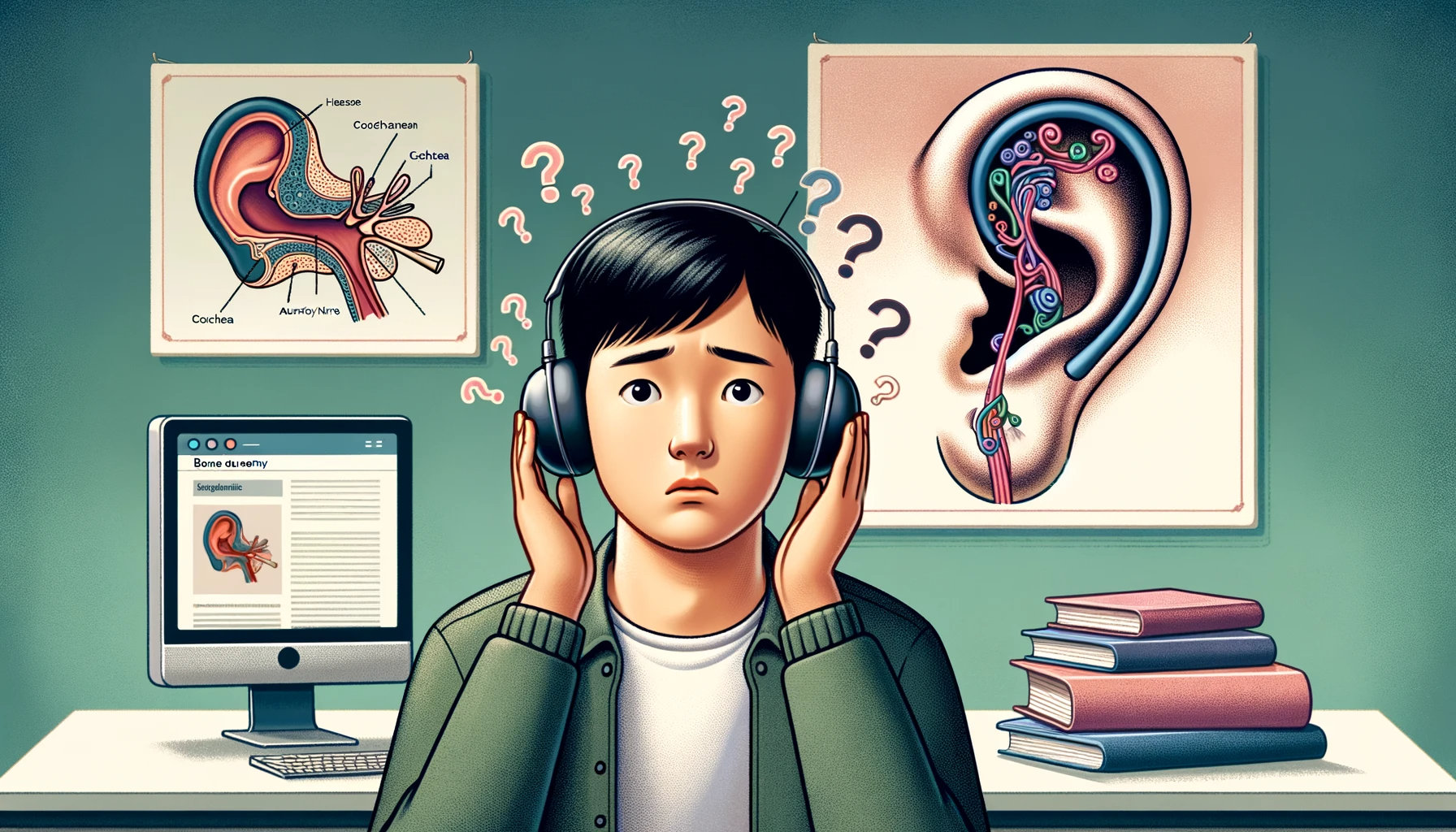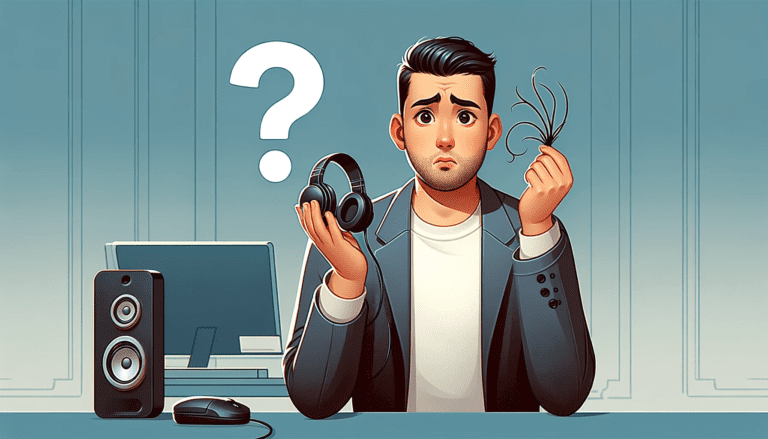Are you seeking groundbreaking technology that can amp up your music experience, but find yourself worrying about potential hearing loss? You’re not alone. The rise in popularity of bone-conduction headphones has sparked heated discussions about their potential health impacts, especially on hearing. Allow us to clear the air and help you discern myth from reality.
This article sets out to answer this burning question: “Can bone conduction headphones cause hearing loss?” The short answer is no, bone conduction headphones do not directly cause hearing loss. However, like any audio technology, when used irresponsibly, they can contribute to hearing damage.
Read on as we dive into the nitty-gritty of bone conduction technology, dispelling myths, and putting your fears to bed.
Understanding Bone Conduction Technology
You might be wondering how exactly bone conduction headphones work. These nifty gadgets leverage the natural abilities of your body, specifically your bones, to conduct sound. That’s right, bones aren’t just for structural support – they also play a pivotal role in how we hear!
Bone conduction headphones rest on your cheekbones and transmit sound waves through vibrations. This is quite different from traditional headphones which send sound waves into your ear canal. When the headphones vibrate, they’re kickstarting the same process that happens when you hear someone speak. Your bones pick up these vibrations and direct them towards your inner ear where they are converted into sounds your brain can interpret.
These headphones give you the chance to listen to your audio content without blocking or damaging your ear canal. They provide more comfort, safety, and ease of use when compared to traditional headphones. You might even forget you’re wearing them!
Let’s get a bit more technical. The sound-producing part of the ear, the tympanic membrane, isn’t involved at all when you’re listening with bone-conduction headphones. Instead, the vibrations sent by these devices bypass the ear canal and eardrum, taking a shortcut straight to the cochlea. From there, the brain processes these as sound. To summarize it in layman’s terms, bone conduction headphones let you listen with your bones!
Note: While it might sound strange or even a bit unsettling, bone conduction is a completely natural process. In fact, we use it all the time when we speak or hear our own voice.
- The vibrations produced by the headphones pass through your cheekbones.
- These vibrations travel to your inner ear.
- Your brain then processes these vibrations as sound.
Overall, bone conduction headphones present a unique and safe way to consume your audio. But the question remains: could this technology potentially cause hearing damage? In the following sections, we dig deeper into this very subject. You may read also You Wear Headphones with Hearing Aids
Are Bone Conduction Headphones Safer than Traditional Headphones?
Let’s delve into a comparison, shall we? Are bone-conduction headphones safer than traditional headphones? While the answer to this question isn’t simple, there are some factors to consider that can shed light on it.
First off, bone conduction headphones, unlike traditional headphones, don’t go directly into your ear canal. Rather, they rest on your head and transmit sound vibration via your cheekbones. This method leaves your ear canal open to ambient sound, providing an added level of safety, especially while cycling, driving, or running outdoors.
On the other hand, traditional headphones, including over-the-ear and in-ear models, can contribute to hearing loss over time because they often encourage volume monitoring problems. Since these headphones drown out ambient noise, you become inclined to crank up the volume to compensate, especially in noisy environments. This increased volume, especially for extended periods, can potentially damage your hearing.
However, it’s essential to note that volume control remains crucial for bone conduction headphones as well. Even though they bypass the ear canal, excessive volume can still pose risks. Precisely because these headphones vibrate your skull to produce sound, setting the volume too high can generate potential hearing risk.
Remember, moderation is key. Any device producing sound close to your ears, regardless of technology, poses potential risks if not used responsibly.
Then, there are physiological differences to consider. Every person is unique! For those with specific hearing disorders like conductive hearing loss, bone conduction headphones can be a significantly safer and more viable option compared to traditional headphones. However, for individuals with normal hearing, this distinction becomes less pronounced.
Lastly, consider the impact on ear health. Traditional headphones, especially earbuds, can promote the buildup of earwax and bacteria in your ear, leading to potential infections. In contrast, bone conduction headphones don’t present this risk, as they don’t physically rest in your ears.
To conclude, contrary to one-size-fits-all verdicts, whether bone conduction headphones are ‘safer’ than traditional ones is largely a determinant of your listening habits, physiological conditions, and personal preferences. As the adage goes, knowledge is power! Armed with these facts, you’re well on your way to making an informed choice the next time you’re headphone shopping.
Dispelling the Myths: Do Bone Conduction Headphones Cause Hearing Loss?
Let’s get straight to the heart of the matter: do bone-conduction headphones contribute to hearing loss? Much of the concern centers on the idea that this technology, bypassing the eardrum, could potentially harm the cochlea—the spiral-shaped part of the inner ear responsible for hearing. However, this belief is largely unfounded. It’s time to dispel some of the most common myths about bone conduction headphones and their impact on hearing health, based on scientific evidence and expert opinions.
Myth 1: Bone conduction headphones cause hearing loss because they bypass the eardrum
This is probably one of the biggest misconceptions about bone conduction headphones. Yes, they do bypass the eardrum, but that doesn’t mean they’re harmful. Instead, by delivering audio directly to the cochlea, they ensure that the sound doesn’t have to pass through any potentially damaged or impaired parts of the outer and middle ear. This makes them a particularly helpful tool for people with certain types of hearing impairment.
Myth 2: Bone conduction headphones expose the inner ear to more noise
Another common misconception is that because bone conduction headphones transmit sound directly to the cochlea, they expose the inner ear to more noise. However, the amount of sound reaching your cochlea—whether through the air or bone conduction—is controlled by your brain’s auditory pathways and regulated to prevent damage. So, you’re no more at risk of hearing loss with bone conduction headphones than with traditional ones, provided you use them responsibly.
Myth 3: The vibrations from bone conduction headphones can damage the skull and brain
Contrary to this belief, the sound waves generated by bone conduction headphones, converted into vibrations, are safe. These vibrations are subtle and well within the range that human bones and tissues can safely absorb. Rest assured, they don’t come with a risk of causing brain damage or skull fractures!
It’s critical to remember, however, that no matter the technology, listening at high volumes for prolonged periods can be harmful to your hearing. This is true whether you’re using bone conduction or traditional headphones. Therefore, be mindful of the volume levels you’re using, and give your ears a break every now and then to prevent possible noise-induced hearing loss. You may read also Do Noise-Canceling Headphones Protect Hearing
Potential Risks and Benefits of Bone Conduction Headphones
Like any other piece of technology, bone conduction headphones come with their own set of potential risks and benefits. While they offer unique advantages and advancements in how we listen to audio, we should also be mindful of any concerns that might arise with their usage. Let’s take a closer look:
Benefits of Bone Conduction Headphones
- Situational Awareness: One of the most celebrated features of bone conduction headphones is their ability to allow you to maintain awareness of your surroundings. As they do not block your ear canal, you can continue to listen to music or podcasts while also being able to hear environmental sounds.
- Comfort and Stability: Traditional in-ear headphones can often be uncomfortable if worn for extended periods and can also fall out easily during vigorous activities. However, most users of bone conduction headphones find them comfortable and stable, even during intense physical activities.
- Safe Hearing Alternative: For individuals with certain types of hearing loss, particularly conductive hearing loss, bone conduction headphones can offer an alternative way to perceive audio without the need for aids or implants.
Potential Risks of Bone Conduction Headphones
- Vibration Sensitivity: Although most people can easily acclimatize to the vibrating sensation of bone conduction headphones, those with hypersensitivity may find the sensation uncomfortable or even distressing.
- Sound Quality: While technology is steadily improving, bone conduction headphones can sometimes deliver lower sound quality compared to traditional headphones, particularly in noisy environments.
- Potential for Misuse: Like any other headphone, bone conduction headphones can still contribute to potential hearing damage if misused. Listening at excessively high volumes for extended periods can potentially result in noise-induced hearing loss, regardless of the headphone type.
To put it all into perspective, bone conduction headphones are a remarkable technology that offer a unique listening experience and benefits such as improved situational awareness and a comfortable fit. However, their usage might not be suitable for everyone, and like traditional headphones, they must be used responsibly to prevent potential hearing issues. It’ll now be interesting to look at what long-term effects might arise from prolonged use of bone conduction headphones.
Long-Term Effects of Using Bone Conduction Headphones
When discussing the long-term effects of using bone conduction headphones, it’s crucial to consider both the potential impacts on hearing health and general comfort. As with any technology, long-term usage should be approached with a mindful and educated perspective.
Starting with general comfort concerns, bone conduction headphones sit on your cheekbones rather than in or over your ears. This positioning can seem peculiar and initially uncomfortable for some people, especially during long-term use. However, over time, most users adapt to the distinct sensation and learn to appreciate the unique benefits that come with this technology – like the ability to maintain awareness of their environments.
When it comes to hearing health, it’s essential to maintain moderation in volume levels to prevent any potential harm. Long-term use at high volumes can lead to noise-induced hearing loss, regardless of whether you’re using bone conduction or traditional headphones. Bone conduction headphones can in fact be a safer alternative if used correctly, as they typically produce fewer decibels than traditional headphones.
Moreover, there aren’t any verified reports showing a direct correlation between prolonged use of bone conduction headphones and hearing loss. However, this doesn’t imply absolute safety, either. Continued medical research is necessary to provide more definitive findings on the subject. Also, people with specific medical conditions, like those related to ears or skull, should consult a healthcare provider before using this technology.
On a positive note, bone conduction headphones provide long-term users with a new way of perceiving sound, even for those with specific types of hearing impairments. Those with conductive hearing loss, for example, can still consume auditory content via bone conduction. This innovative experience has shown to be an incredible boon to many in the long run, making these devices more than just a gadget but also a potential tool for more inclusive communication. You may see also Do Headphones Cause Hair Loss
Comparing Bone Conduction Headphones and In-Ear Headphones: Which is Safer?
When it comes to weighing safety, both bone conduction headphones and in-ear headphones come with risks and benefits. Most of these are closely linked to how each type of device operates and how they’re used. So, let’s dig into the details a bit further.
Bone conduction headphones
Bone conduction headphones, as detailed earlier, deliver sound through your bones. They rest on your cheekbones and leave your ear canals open. This feature allows you to be more aware of your surroundings while using them, making them ideal for outdoor activities such as running, cycling, or hiking. This means reduced risk for accidents tied to sensory deprivation normally associated with normal headphones. However, as we discussed in the potential risks section, they may potentially cause discomfort due to vibration at higher volumes and when used over prolonged periods.
In-ear headphones
In-ear headphones, on the other hand, transmit sound directly into your ear canals. This provides better sound isolation and noise-cancellation, ideal for noisy environments or for the full auditory experience. But this can also be a drawback. It could be harmful if mismanaged, contributing to noise-induced hearing loss if consistently used at high volumes. Furthermore, your awareness of your surroundings is essentially cut off, which poses some safety risks, particularly while outdoors.
In essence, it boils down to user discipline when using any kind of headphones. Both devices can protect your hearing as long as you manage the volume levels carefully and take regular breaks. That said, if you often find yourself in need to stay audibly connected with your surroundings while jamming to your favorite tunes, bone conduction headphones could be the safer choice.
Table: Comparing Bone Conduction Headphones and In-Ear Headphones
| Bone Conduction Headphones | In-Ear Headphones | |
|---|---|---|
| Operating Principle | Delivers sound through the cheekbones | Delivers sound directly into the ear canals |
| Auditory Awareness | Allows you to hear your surroundings | Limits the awareness of surroundings |
| Potential Risks | Vibration discomfort at high volumes and prolonged use | Higher risk of noise-induced hearing loss and reduced environmental awareness |
| Best Used For | Outdoor activities like running, hiking, cycling | Quieter environments or for better noise-cancellation |
Audiologist’s Perspective on Bone Conduction Headphones
We’ve explored the mechanics of bone conduction headphones, debunked some common myths, and examined potential risks and benefits. Now, let’s dive deeper into the expert’s realm and examine the perspective of an audiologist on these devices.
Audiologists are healthcare professionals who specialize in hearing, balance disorders, and other related issues. They have a keen understanding of auditory systems, acoustics, and sound technology, including headphones and devices that utilize bone conduction technology.
“Bone conduction technology, utilized for decades in hearing aids, has been designed to aid those with specific types of hearing loss. The application of this technology in headphones does not inherently pose risks of hearing loss, provided that they are used responsibly.” – An accredited Audiologist
However, like any sound-producing device, bone conduction headphones need to be used with care. Volume levels and listening duration are vital factors. Audiologists generally recommend following the 60/60 rule: listening to audio at no more than 60% volume for no longer than 60 minutes at a time. This applies to all headphones, including bone conduction ones.
Furthermore, audiologists emphasize that bone conduction headphones are not a cure or solution for hearing loss. People with existing hearing disorders should consult their healthcare provider before switching to or regularly using bone conduction headphones. The ultimate concern should be the health of one’s hearing and protection from noise-induced hearing damage.
Ultimately, audiologists view bone conduction headphones as just another sound device that, when used correctly, shouldn’t pose significant risks to your hearing health. But of course, it’s crucial to use these devices wisely and look after your ears – they’re your connection to the world of sound and deserve the utmost respect and care. You may read the guide on Can Headphones Cause Tinnitus
Conclusion
In conclusion, bone conduction headphones, as proven by scientific research and expert opinion, do not inherently cause hearing loss. While they produce sound through vibration and send it directly to the inner ear, they do not expose the ear to more noise than traditional headphones, nor do they damage the skull or brain with their vibrations.
As with any audio device, potential risks can arise from misuse or overexposure to high volume levels, but with proper use, bone conduction headphones can even offer advantages such as preserving situational awareness and reducing ear fatigue. The key to preserving hearing health is mindful use, no matter what type of headphones you choose.







